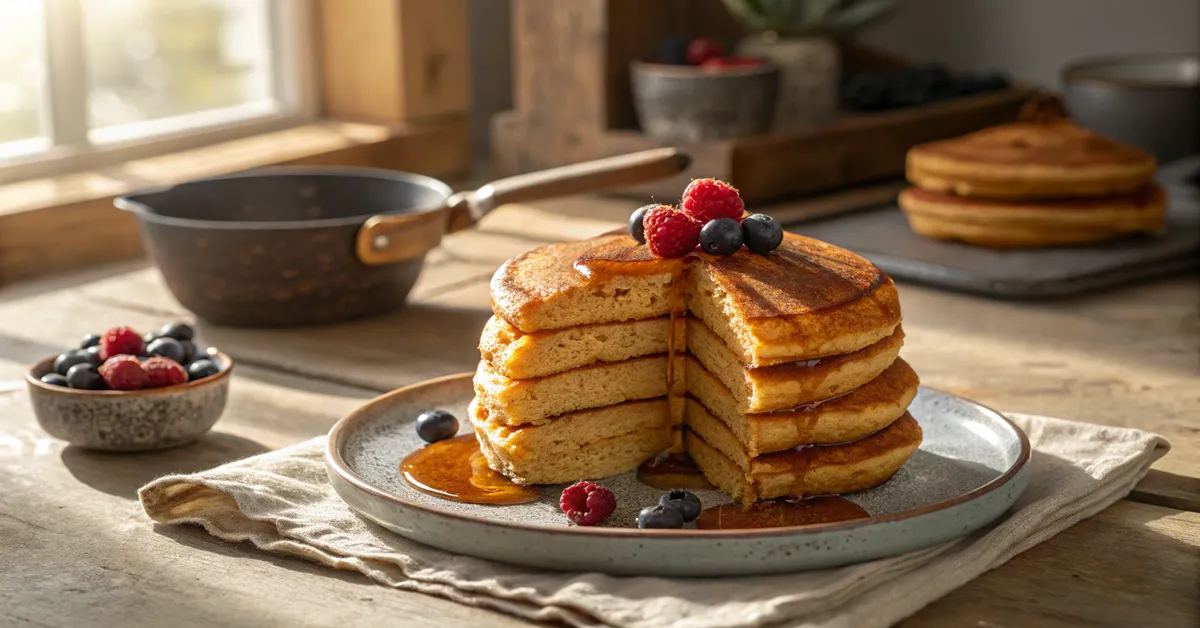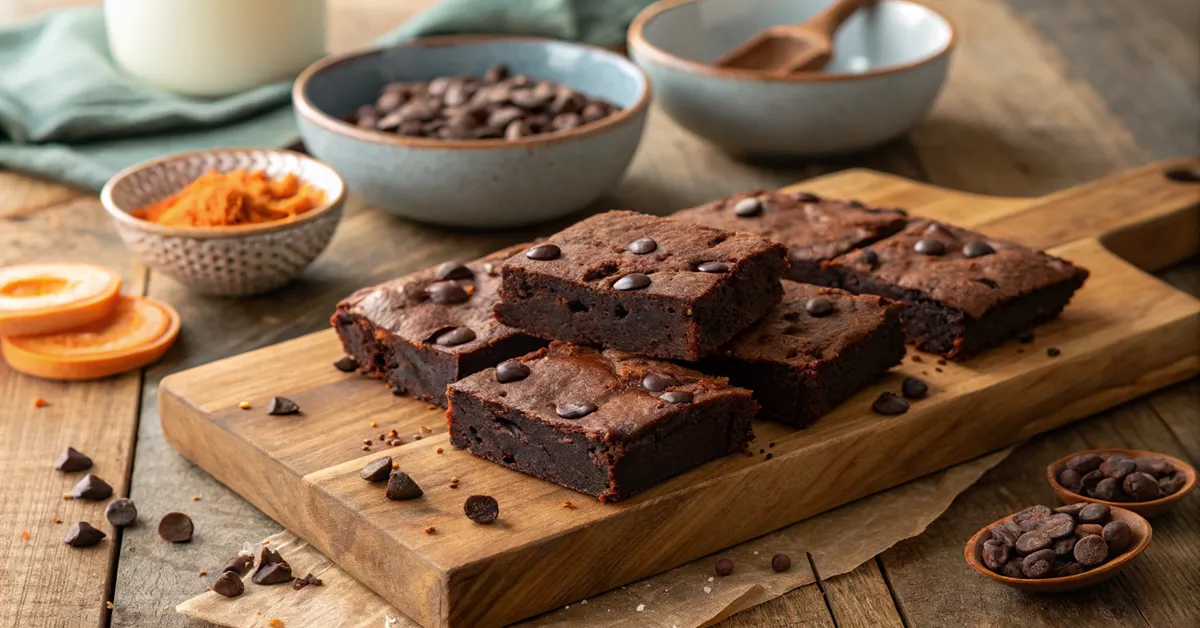Hummus Basar – The Ultimate Guide to the Middle Eastern Meat and Chickpea Delight
When it comes to Middle Eastern cuisine, few dishes spark as much excitement and craving as hummus basar. This rich, savory dish combines the creamy smoothness of traditional hummus with the bold flavor of spiced ground meat—creating a hearty, satisfying favorite across cultures. Whether you’re discovering hummus basar for the first time or looking to elevate your homemade recipes, this guide dives deep into every aspect of this mouthwatering Mediterranean classic.
We’ll explore what makes hummus basar special, how it’s made, the best dishes to serve alongside it, and even some cultural insights you may not have known.
Discover great ideas like chimichurri hummus for more Mediterranean flavor pairings.
Let’s dive into the origins and meaning of hummus basar.
Table of Contents
Table of Contents
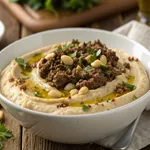
Hummus Basar – Authentic Middle Eastern Meat and Chickpea Delight
- Total Time: 30 minutes
- Yield: 4 servings
Description
Hummus basar is a classic Middle Eastern dish combining creamy chickpea hummus with savory, spiced ground meat, topped with toasted pine nuts and a drizzle of olive oil. This hearty dish serves perfectly as an appetizer or main course and brings authentic Mediterranean flavors straight to your table.
Ingredients
Ingredients
1 cup dried chickpeas (or 2 cans cooked chickpeas, drained and rinsed)
½ cup tahini (smooth, high-quality)
2-3 cloves fresh garlic
¼ cup fresh lemon juice
¼ cup extra virgin olive oil (plus extra for drizzling)
Salt, to taste
1 lb ground lamb or ground beef
1 medium onion, finely diced
¼ cup pine nuts, toasted
1 tsp ground cumin
1 tsp sweet paprika
½ tsp cinnamon
2-4 tbsp cold water (to adjust hummus consistency)
Instructions
Step By Step Instructions
Cook Chickpeas: If using dried chickpeas, soak overnight and boil until tender (about 1 hour).
Make Hummus: In a food processor, blend chickpeas, tahini, lemon juice, garlic, and olive oil until smooth. Add cold water slowly to reach desired consistency. Season with salt.
Toast Pine Nuts: In a dry skillet over medium heat, toast pine nuts until golden. Set aside.
Prepare Meat: Heat olive oil in a skillet. Sauté onions until soft. Add ground meat, cooking until browned. Stir in cumin, paprika, cinnamon, salt, and pepper.
Assemble Dish: Spread hummus in a shallow bowl, create a well, and spoon meat mixture on top. Garnish with toasted pine nuts and a drizzle of olive oil.
- Serve: Enjoy immediately with pita bread and fresh sides.
Notes
- Use warm chickpeas for a smoother hummus texture.
- Adjust spices to taste—feel free to add chili flakes for heat.
- Store hummus and meat separately if making ahead.
- Serve with fresh pita, grilled veggies, or as part of a mezze spread.
- Prep Time: 15 minutes
- Cook Time: 15 minutes
- Category: Mediterranean launch recipe
- Method: Blending, Sautéing
- Cuisine: Middle Eastern / Mediterranean
Nutrition
- Serving Size: 1 portion (approx. 250g)
- Calories: 450 kcal
- Sugar: 2 g
- Sodium: 450 mg
- Fat: 32 g
- Saturated Fat: 6 g
- Unsaturated Fat: 23 g
- Trans Fat: 0 g
- Carbohydrates: 20 g
- Fiber: 6 g
- Protein: 22 g
- Cholesterol: 55 mg
What is Hummus Basar? Exploring Its Origins and Meaning
The Story Behind Hummus Basar
Hummus basar isn’t just an inventive arrangement of flavors; it translates directly from Hebrew and Arabic to “hummus with meat.” It’s a favorite recipe in many a Middle Eastern kitchen, a mixing of two staple ingredients — creamy ground chickpea hummus and spiced savory ground meat. Classic hummus is commonly presented on a platter as a dip or spread, but hummus basar kicks it up a notch by topping the smooth hummus base with seasoned ground beef or lamb.
Some historians of food culture contend that hummus basar came out of Levant street food culture, where cooks began to throw warm meat on top of the traditionally cold hummus dish. This hardy combo made a rapid rise, particularly in Israel, Lebanon, and Syria, delighting locals and tourists alike.
What differentiates hummus basar is the way it turns a humble chickpea dip into an entire meal. The spiced meat topping provides protein, richness and a lovely contrast to the creamy grassy hummus below, seasoned with spices like cumin, paprika and pine nuts.
Traditional Roots of Hummus and Its Meat Topping
Grasping the concept of hummus basar requires an appreciation of the history and origins of hummus itself. Rooted in Levantine and Mediterranean culinary traditions, hummus dates back thousands of years, with each region adding its unique twist. Chickpeas, tahini, lemon, and garlic form the traditional base—a creamy, flavorful, and nutritious spread.
In countries like Syria and Lebanon, hummus is often part of a mezze platter—a variety of small dishes meant for sharing. The addition of ground meat on top likely came as a way to make hummus more filling for main courses or street snacks. In Israel, hummus basar became synonymous with hearty comfort food.
Today, hummus basar stands as a symbol of culinary fusion—combining the best of chickpea hummus with the rich textures of seasoned meat. It bridges the gap between appetizer and main dish, loved by foodies, home cooks, and chefs alike.
Why Hummus Basar is a Must-Try Mediterranean Dish
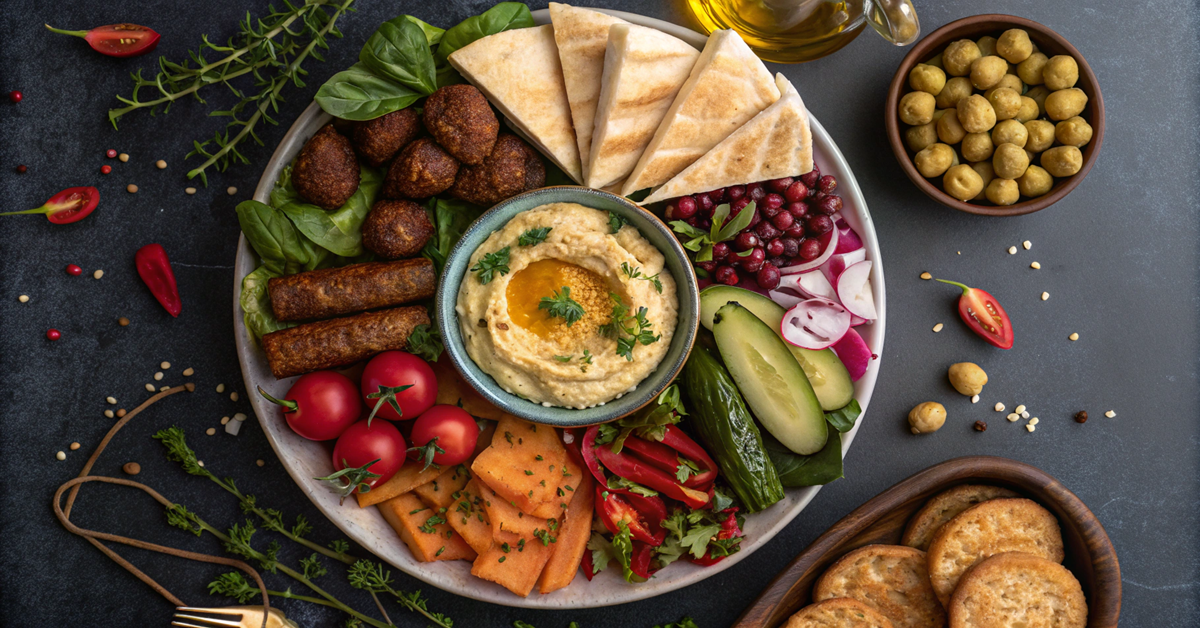
Unique Flavor Combination of Hummus Basar
One bite of hummus basar is enough to understand why this Mediterranean dish has captured hearts around the world. At its core, hummus basar is all about contrast and balance. The silky, creamy texture of classic hummus—made from chickpeas, tahini, garlic, and lemon juice—pairs perfectly with the bold, savory richness of spiced ground meat.
The seasoned meat topping typically features ground beef or lamb, sautéed with onions, pine nuts, and a spice blend that may include cumin, paprika, cinnamon, and coriander. This mixture is spooned over a generous layer of hummus, allowing the warm flavors of the meat to meld with the cool, creamy hummus underneath.
Not only does hummus basar taste incredible, but its textures also play a key role. The smooth hummus contrasts with the slightly crisp edges of sautéed meat, while toasted pine nuts add a welcome crunch. This combination creates a flavor explosion that’s hard to resist.
When served with warm pita bread, fresh vegetables, or even as a topping for grain bowls, hummus basar quickly transforms from a simple dip to a hearty, satisfying meal.
Learn more about couscous and quinoa salad for an ideal pairing with your hummus dishes.
Cultural Significance and Growing Popularity Worldwide
Beyond its flavor, hummus basar holds a special place in Middle Eastern culinary traditions. In countries like Israel, Lebanon, and Syria, this dish is often featured in family gatherings, street food stalls, and upscale restaurants alike. Its roots run deep in Levantine food culture, representing both tradition and innovation.
As Mediterranean cuisine continues to gain global attention for its health benefits and bold flavors, hummus basar has emerged as a standout dish on international menus. Food lovers in the USA and Europe are discovering its appeal—not just as an appetizer, but as a versatile, protein-packed entrée.
Modern chefs often experiment with hummus basar, adding unique spices or fusion twists, making it a dynamic dish that appeals to a wide audience. Despite its variations, the essence of hummus basar remains the same—a comforting, flavorful blend of hummus and meat that speaks to its rich cultural heritage.
In essence, hummus basar isn’t just a dish—it’s an experience, bringing together history, flavor, and heart in every bite.
The Key Ingredients that Make Hummus Basar Authentic
Classic Hummus Ingredients: Chickpeas, Tahini, and Garlic
At the heart of every hummus basar recipe is a classic, velvety hummus base. This creamy dip isn’t just a side dish—it’s the foundation that elevates the flavors of the entire dish. Let’s break down the key ingredients that make this hummus perfect for pairing with seasoned meat.
- Chickpeas (Garbanzo Beans): The star of the show, chickpeas provide a creamy, hearty texture when blended. For truly authentic hummus basar, using dried chickpeas soaked overnight offers the best flavor and consistency.
- Tahini: This sesame paste contributes a deep, nutty flavor and a smooth texture that unifies the hummus. The quality of tahini matters—a smooth, slightly runny tahini works best.
- Garlic: Fresh garlic gives the hummus its signature kick. Whether blended into the hummus or used as a seasoning, garlic enhances every bite of hummus basar.
- Lemon Juice: Freshly squeezed lemon juice enhances the hummus with brightness and counteracts the richness of tahini and meat
- Olive Oil: A drizzle of extra virgin olive oil over the finished hummus not only adds flavor but also creates that restaurant-quality presentation.
These simple ingredients, when combined, create the traditional hummus that serves as the flavorful base for hummus basar.
The Perfect Ground Meat for Hummus Basar
The second essential element of hummus basar is the savory ground meat topping. Choosing the right meat and preparing it with care is what sets authentic hummus basar apart from other hummus variations.
- Ground Beef or Lamb: While both meats are commonly used, ground lamb is traditional in many Middle Eastern recipes due to its rich, distinct flavor. Ground beef offers a leaner, milder option but still delivers excellent taste when seasoned well.
- Onions: Sautéed onions bring out the sweetness in the meat and add depth to the flavor profile. They are often cooked until soft and golden before the meat is added.
- Pine Nuts: Toasted pine nuts not only enhance texture but also add a buttery, nutty taste that complements both the hummus and the meat.
- Spices: The secret to unforgettable hummus basar lies in its spices. A standard blend features cumin, paprika, cinnamon, allspice, and occasionally coriander. These spices infuse the meat with warmth and complexity, creating a blend that perfectly balances the creamy hummus base.
- Olive Oil: Used for sautéing and drizzling, olive oil helps carry the flavors and ensures the meat remains juicy and tender.
Check out Mediterranean shrimp bowl for another protein-rich Mediterranean dish idea.
The balance of flavors between the seasoned meat and traditional hummus is what elevates hummus basar to a remarkable dish. When prepared with fresh, high-quality ingredients, it delivers a dining experience that feels both traditional and indulgent.
How to Make Authentic Hummus Basar at Home
Step-by-Step Hummus Basar Recipe
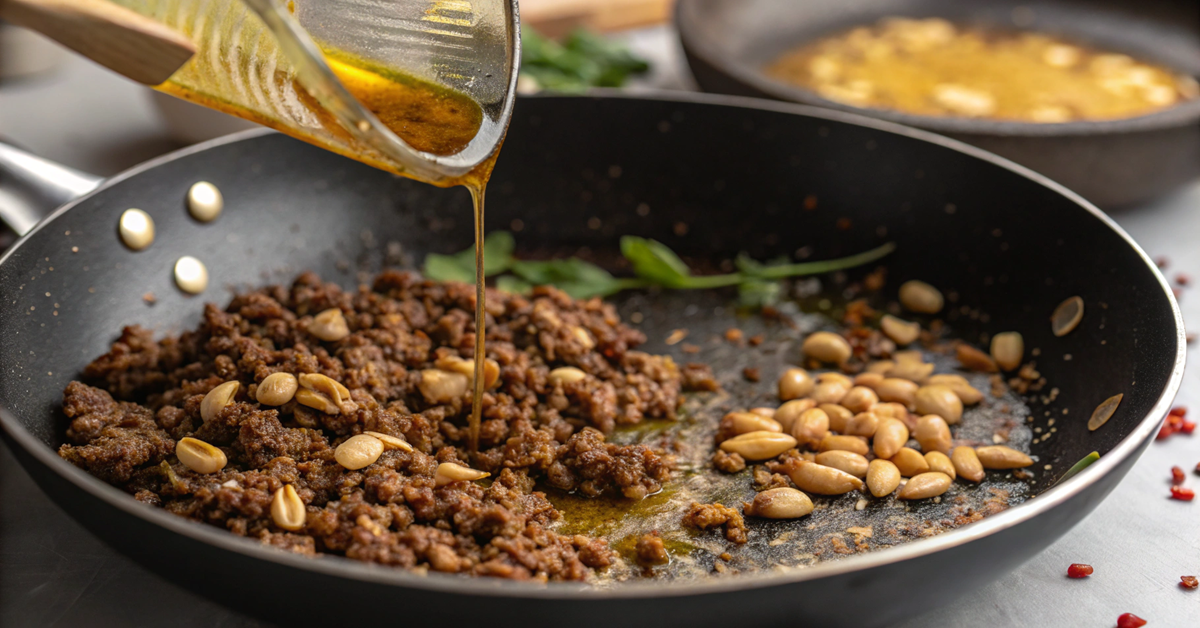
Making hummus basar at home may seem intimidating, but with the right ingredients and a little patience, you’ll have a dish that rivals your favorite Mediterranean restaurant. Follow this easy recipe to bring authentic hummus basar to your table.
Ingredients for the Hummus:
- 1 cup of dried chickpeas (or alternatively, 2 cans of cooked chickpeas)
- ½ cup tahini (preferably smooth and runny)
- 2-3 cloves fresh garlic
- ¼ cup fresh lemon juice
- ¼ cup extra virgin olive oil
- Salt to taste
- Water as needed for blending
Ingredients for the Meat Topping:
- 1 lb ground lamb or ground beef
- 1 medium onion, finely diced
- ¼ cup pine nuts, toasted
- 2 tbsp olive oil
- 1 tsp ground cumin
- 1 tsp sweet paprika
- ½ tsp cinnamon
- Salt and black pepper to taste
Instructions:
- Prepare the Chickpeas: If using dried chickpeas, soak them overnight in water. The following day, rinse and simmer them in fresh water until tender (approximately 1 hour). If using canned, rinse and drain well.
- Make the Hummus Base: In a food processor, blend together chickpeas, tahini, lemon juice, garlic, olive oil, and a dash of salt. Blend until smooth, adding water slowly until you achieve a creamy consistency. Adjust seasoning as needed.
- Toast the Pine Nuts: In a dry skillet over medium heat, toast pine nuts until golden brown. Set aside.
- Cook the Meat: In a skillet, heat olive oil and sauté onions until translucent. Incorporate the ground meat, using a spoon to crumble it as you add it. Cook until browned. Season with cumin, paprika, cinnamon, salt, and pepper. Stir well to combine.
- Assemble the Hummus Basar: Spread the hummus on a large serving plate, creating a slight well in the center. Layer the cooked meat over the hummus and finish with a sprinkle of toasted pine nuts. Finish with a drizzle of olive oil.
- Serve: Enjoy hummus basar warm with fresh pita bread, veggies, or as part of a mezze spread.
Don’t miss our Mediterranean breakfast bowl for more Mediterranean-inspired meal ideas.
Tips for Achieving the Best Texture and Flavor
- Use Fresh Ingredients: Fresh garlic, high-quality tahini, and freshly cooked chickpeas make a noticeable difference in taste.
- Blend Hummus Until Super Smooth: Don’t rush the blending process. Be patient to achieve a smooth, creamy texture without lumps.
- Balance the Spices: Don’t overpower the hummus with too much seasoning. Allow the inherent flavors of the chickpeas and tahini to stand out, enhanced by the seasoned meat.
- Serve Fresh: Hummus basar tastes best freshly prepared.If preparing in advance, keep the components stored separately and combine them right before serving.
- Customize Spice Levels: Adjust the spice blend to your taste. Want more heat? Add a dash of chili flakes. Prefer it mild? Go easy on the spices.
Mastering hummus basar at home means you can enjoy this Mediterranean classic anytime you crave it. Plus, it’s a guaranteed crowd-pleaser at gatherings.
What to Serve with Hummus Basar?
Best Side Dishes and Mediterranean Pairings
Hummus basar is not only delicious on its own, but it also pairs perfectly with a variety of Mediterranean sides that enhance its rich flavors. Whether you’re serving it at a casual family dinner or as part of a mezze spread, these pairings bring out the best in your dish.
- Fresh Pita Bread: The classic choice. Warm, fluffy pita bread is perfect for scooping up creamy hummus and savory meat. Opt for fresh or homemade pita for the ultimate experience.
- Couscous and Quinoa Salad: A light, refreshing side that balances the hearty flavors of hummus basar. The mix of grains, herbs, and citrus complements the spices beautifully.
Learn more about couscous and quinoa salad for the perfect pairing ideas. - Grilled Vegetables: Zucchini, bell peppers, and eggplant grilled to perfection provide a smoky contrast to the creamy hummus and spiced meat.
- Pickled Vegetables: Tangy pickles, olives, and turnips cut through the richness of hummus basar and add a zesty bite.
- Mediterranean Shrimp Bowl: Want a seafood pairing?
Check out Mediterranean shrimp bowl for a protein-rich complement to your hummus platter. - Fattoush or Tabbouleh Salad: These vibrant, herb-packed salads bring freshness and crunch that pairs wonderfully with the hearty texture of hummus basar.
Serving hummus basar with a variety of sides turns a simple dish into a full Mediterranean feast that satisfies every palate.
Serving Suggestions for Parties and Family Meals
For parties, hummus basar can easily become the star of your appetizer table. Serve it in a large shallow bowl with a generous drizzle of olive oil and a sprinkle of pine nuts. Accompany it with warm pita triangles, crisp vegetables, and an array of Mediterranean salads.
For family meals, you can serve hummus basar as a main course accompanied by side dishes like rice pilaf, roasted potatoes, or a hearty Mediterranean breakfast bowl.
Don’t miss our Mediterranean breakfast bowl if you’re looking for easy breakfast pairing ideas.
Hummus basar also works great as a topping for flatbreads or in wraps, making it a versatile addition to your mealtime lineup.
Whether you’re hosting a gathering or just want a comforting family dinner, knowing what to serve with hummus basar helps create a satisfying and memorable meal.
Is Hummus Tahini Healthy? The Nutrition Breakdown
Health Benefits of Chickpeas and Tahini
A big part of what makes hummus basar so popular—besides its bold, comforting flavors—is the nutritional powerhouse it packs, especially in its hummus base. The combination of chickpeas and tahini isn’t just delicious; it’s loaded with nutrients that offer real health benefits.
- Chickpeas: These humble legumes are rich in protein, fiber, and essential vitamins like folate and iron. Eating chickpeas regularly can help support heart health, improve digestion, and maintain stable blood sugar levels. They also keep you feeling fuller for longer, making them an excellent choice for balanced meals.
- Tahini: Made from sesame seeds, tahini is packed with healthy fats, calcium, magnesium, and antioxidants. It contains anti-inflammatory properties and can help support bone health. Even though tahini is calorie-dense, its monounsaturated fats make it a heart-healthy ingredient when eaten in moderation.
When combined, chickpeas and tahini create a creamy, nutrient-rich spread that forms the foundation of every great hummus basar dish.
Nutritional Impact of Adding Ground Meat to Hummus Basar
So, is hummus tahini healthy when paired with seasoned meat? The answer depends on how you prepare and enjoy it.
- Ground Meat Benefits: Ground beef or lamb adds high-quality protein and essential nutrients like iron, zinc, and B vitamins. Protein supports muscle growth and keeps you feeling satisfied after meals. However, it’s important to choose lean cuts and avoid overcooking to maintain nutritional balance.
- Mindful Cooking Methods: Sautéing meat in healthy fats like olive oil and using spices instead of heavy sauces keeps the dish lighter without sacrificing flavor.
- Portion Control: While hummus basar is nutrient-dense, watching portion sizes helps manage calorie intake—especially when paired with other sides like pita bread or salads.
Compared to many processed or fast-food dishes, hummus basar offers a healthier option packed with protein, fiber, and beneficial fats—making it a smart choice for those seeking balanced Mediterranean meals.
In short, when enjoyed as part of a balanced diet, hummus basar can be a nutritious, satisfying meal that delivers on both taste and wellness.
The Hummus Wars – Who Won the Battle for the Best Hummus?
The Middle Eastern Hummus Rivalries Explained
When talking about hummus basar, it’s impossible to ignore the cultural and culinary rivalries that have surrounded hummus for decades. The so-called “Hummus Wars” refer to a friendly yet passionate competition among Middle Eastern countries like Lebanon, Israel, Palestine, and Syria—each claiming ownership of the best hummus recipe.
These rivalries aren’t just about food; they reflect deep cultural pride and culinary heritage. Hummus, being a staple across the Levant, naturally inspires debate over whose version is the most authentic, the tastiest, or the most traditional.
In 2009, Lebanon even set a world record by making the largest plate of hummus—a statement of culinary identity that made headlines worldwide. Meanwhile, Israel popularized variations like hummus basar, bringing a creative twist to the classic hummus with the addition of seasoned ground meat.
This lighthearted rivalry has contributed to the global popularity of hummus—and, by extension, hummus basar. Rather than creating conflict, the Hummus Wars have sparked a global love affair with this creamy, nutritious dish.
Don’t miss our Mediterranean breakfast bowl if you’re interested in exploring other popular Mediterranean meals that have crossed cultural boundaries.
Where Does Hummus Basar Stand in the Hummus Wars?
While traditional hummus purists may debate over origins, hummus basar carves its own niche in this culinary saga. Unlike classic hummus served plain with a drizzle of olive oil, hummus basar transforms the dish into a hearty, savory meal—appealing to modern tastes while staying rooted in traditional flavors.
Israel is widely credited with popularizing hummus basar, especially in street markets and local eateries where innovation meets tradition. However, variations of hummus topped with meat can be found in Lebanon, Syria, and Palestine as well, showcasing the dish’s widespread appeal.
So, who won the Hummus Wars? In truth, everyone did. The global obsession with hummus—and its many delicious forms, including hummus basar—proves that this dish transcends borders and unites food lovers everywhere.
Whether you enjoy classic hummus or crave the rich flavors of hummus basar, there’s no wrong way to savor this Mediterranean masterpiece.
Hummus in Arabic Culture – What Do Syrians Call Hummus? & How Do Arabs Say Hummus?
Understanding Hummus Names in Different Arab Regions
Hummus transcends being merely a dish; it embodies cultural importance throughout the Arab world. In Syria, Lebanon, Palestine, Jordan, and other Levantine countries, hummus (pronounced ḥummuṣ) refers directly to chickpeas. The term originates from the Arabic word ḥummuṣ, which translates to ‘chickpeas.
When Syrians refer to the beloved chickpea dip, they commonly say ḥummuṣ bi ṭaḥīna, which translates to “chickpeas with tahini.” This distinction matters in Arabic culture because ḥummuṣ alone means the legume, while the full phrase refers to the dish we know and love worldwide.
In Syrian households, you’ll hear people asking for ḥummuṣ bi ṭaḥīna when they want the classic creamy spread. However, when ordering dishes like hummus basar, locals often simply say ḥummuṣ bil-lahmeh, meaning “hummus with meat.”
These subtle language differences reflect the deep culinary traditions embedded in daily life, making hummus basar a dish that feels both familiar and beloved in Arab kitchens.
Cultural Pronunciations and Regional Twists on Hummus
Across the Arab world, the pronunciation of hummus varies slightly by region but remains universally recognized. In Levantine dialects, it’s often pronounced ḥummuṣ with a soft “ḥ” sound—a throaty “h” that doesn’t quite exist in English.
In Egypt, the dish is sometimes called ḥummuṣ bi ṭaḥīna, similar to Syria, while in Gulf countries, the name remains the same, though accents differ. Despite pronunciation differences, the love for hummus—and especially for hearty variations like hummus basar—crosses all cultural and linguistic lines.
Interestingly, some regional twists on hummus basar include unique spice blends or serving styles. For example:
- In Syria, pine nuts and a sprinkle of Aleppo pepper add heat and texture.
- In Lebanon, a drizzle of pomegranate molasses gives the dish a sweet-tart finish.
- In Israel, hummus basar often comes topped with fresh herbs and a generous pour of olive oil.
These local touches ensure that wherever you enjoy hummus basar, it reflects both its rich history and regional flair.
How to Make Hummus Taste Better? Chef-Approved Secrets
Flavor Boosters and Seasoning Tips for Hummus Basar
Making a great hummus basar is as much about technique as it is about ingredients. Even with the right components, a few simple tips can take your hummus from good to unforgettable.
- Use Warm Chickpeas: Blending chickpeas while they’re still warm creates a smoother, creamier hummus. The heat helps the tahini blend more evenly, resulting in a better texture.
- Balance Garlic and Lemon: Too much garlic can overpower the delicate flavors of hummus basar. Use fresh garlic but don’t overdo it. Lemon juice should brighten the hummus, not make it sour.
- Add Ice Water for Creaminess: For ultra-smooth hummus, add a few tablespoons of ice-cold water while blending. This emulsifies the tahini and chickpeas, giving your hummus that perfect airy texture.
- Don’t Skimp on Olive Oil: A generous drizzle of high-quality extra virgin olive oil adds depth and richness. It also enhances the mouthfeel of both the hummus and the spiced meat.
Top Garnishes and Presentation Ideas
The visual appeal of hummus basar matters just as much as its flavor. Here are some chef-approved ways to garnish and present your dish like a pro:
- Toasted Pine Nuts: Add texture and a buttery flavor that pairs perfectly with both the hummus and meat.
- Fresh Herbs: Chopped parsley, cilantro, or mint adds color and a burst of freshness.
- Aleppo Pepper or Paprika: A sprinkle of mild chili flakes or sweet paprika creates a beautiful contrast on top of the hummus.
- Whole Chickpeas: A spoonful of cooked chickpeas in the center of the hummus brings a rustic, authentic touch.
- Sumac Powder: This tangy spice adds a lemony note and vivid color when sprinkled lightly over the top.
For serving, spread the hummus in a shallow bowl, make a swirl or well in the center, and pile the cooked, seasoned meat on top. Drizzle olive oil liberally and finish with your choice of garnishes.
Presentation isn’t just for show—it sets the stage for a flavorful experience that highlights the richness of hummus basar and its Middle Eastern roots.
Frequently Asked Questions About Hummus Basar
What to serve with hummus basar?
Hummus basar pairs wonderfully with warm pita bread, fresh vegetables like cucumbers and carrots, and classic Mediterranean salads such as couscous and quinoa salad. You can also serve it with grilled vegetables, pickled turnips, or even a Mediterranean shrimp bowl for a complete meal.
Learn more about couscous and quinoa salad and check out Mediterranean shrimp bowl for pairing ideas.
Is hummus tahini healthy?
Yes, hummus made with tahini is considered healthy. Chickpeas are a great source of plant-based protein and fiber, while tahini provides healthy fats, calcium, and antioxidants. When paired with moderate amounts of seasoned ground meat—as in hummus basar—it remains a balanced, nutrient-rich dish that can support a healthy diet when enjoyed in reasonable portions.
Who won the hummus wars?
The “Hummus Wars” is more about culinary pride than competition. Nations such as Lebanon, Israel, Palestine, and Syria all assert that their rendition of hummus is the finest. Lebanon once set a Guinness World Record for the largest hummus dish, but the real winners are food lovers worldwide who enjoy classic hummus and creative variations like hummus basar.
What do Syrians call hummus?
In Syria, the dish is typically referred to as ḥummuṣ bi ṭaḥīna, which translates to ‘chickpeas with tahini.’ When it comes to hummus topped with meat, Syrians use the term ḥummuṣ bil-lahmeh, meaning ‘hummus with meat.This reflects the dish’s cultural importance in Syrian cuisine, where hummus is a beloved staple.
How do Arabs say hummus?
Across the Arab world, hummus is pronounced ḥummuṣ—with a soft “ḥ” sound that is unique to Arabic. The term refers to chickpeas in general, while the dish itself is called ḥummuṣ bi ṭaḥīna when prepared as a creamy dip. Variations like ḥummuṣ bil-lahmeh highlight regional differences but share a common love for this iconic dish.
What makes hummus taste better?
To make hummus basar taste better, use freshly cooked chickpeas, quality tahini, and the right balance of lemon juice and garlic. Blending with ice-cold water ensures a smooth texture, while toppings like toasted pine nuts, fresh herbs, and a drizzle of olive oil elevate the dish. The spices in the ground meat also play a big role—so don’t skip on seasoning!
Looking for inspiration? Try Moroccan fish in 4 simple steps for more flavor-enhancing tips from Mediterranean cooking.
Why Hummus Basar Deserves a Spot on Your Table

From its deep cultural roots to its irresistible flavor, hummus basar stands out as a Mediterranean dish that truly has it all—creamy hummus, savory spiced meat, and endless ways to enjoy it. Whether you’re looking for a hearty appetizer, a shareable dish for family gatherings, or a unique addition to your mezze platter, hummus basar brings bold taste and tradition together in every bite.
We’ve explored its origins, learned how to make it authentically at home, and uncovered the best sides and flavor secrets that make this dish shine. More than just food, hummus basar is a celebration of Mediterranean heritage and a perfect example of how simple ingredients, when combined thoughtfully, create something extraordinary.
Don’t miss our Mediterranean breakfast bowl for more ideas on bringing Middle Eastern flavors into your kitchen.
Ready to impress your guests or treat yourself to a rich, satisfying meal? Make hummus basar part of your next culinary adventure.

